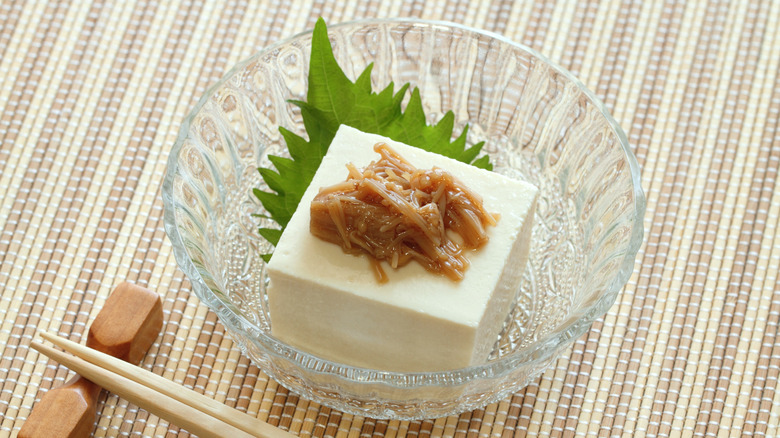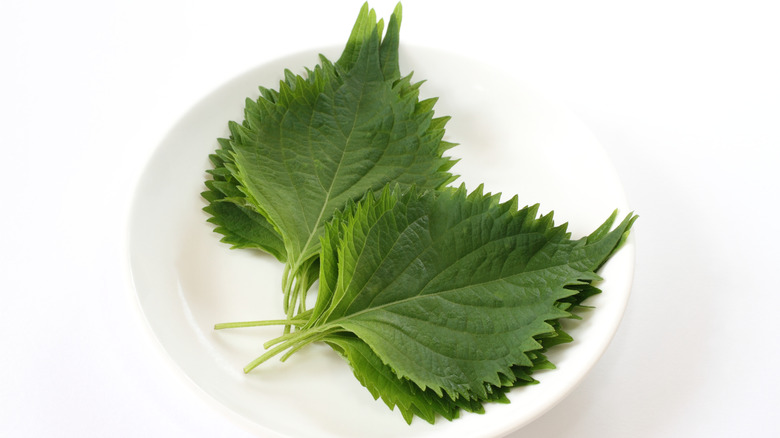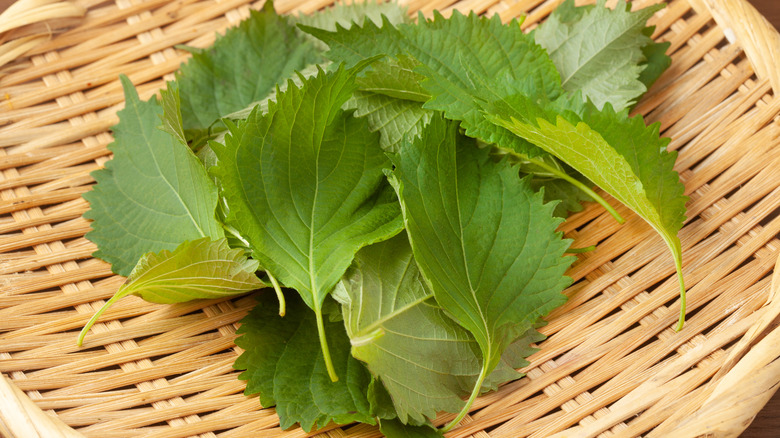What Is Shiso And What Does It Taste Like?
Even if you never encountered shiso at the grocery store, you may have enjoyed this special ingredient without even knowing it. According to The New York Times, shiso, sometimes known as perilla and beefsteak herb, has a bright taste, reminiscent of mint or basil. It also has hints of cinnamon, anise, and cilantro. The leaves of the plant also tend to have a slight bite, similar to ginger. While the beguiling herb has a flavor that is challenging to pin down, it immediately makes an impression and can elevate any dish. It has a robust flavor that stands up to lots of different flavors and ingredients.
Many chefs use the herb's picturesque leaves as a garnish, but they lend a delicious herbaceous note to any recipe they're incorporated into and increase the appeal of shiso – it looks like the real-world rendering of what an illustrator might draw if asked for a drawing of a leaf. Food52 deems shiso an Asiatic cousin to basil. It hails from India and China but has found a special place in Japanese cuisine. While the shiso we know today didn't grow in Japan until the 1960s, it has truly found a place in kitchens worldwide thanks to its versatility (via Nion).
What does shiso taste like?
While most shiso is green, a reddish-purple variation also exists. Red shiso has a spicier bite and can often add a bitter note to salads. Chefs often use red-tinted shiso to help flavor umeboshi, a Japanese pickled plum. Some also like to deep-fry shiso, while other chefs sautée it like spinach. It's delicious in stir-fried noodles dishes, simple syrups, Vietnamese summer rolls, desserts, and shiso mako, which consists of walnuts, miso, shiso, and eggplant.
Murray's Cheese actually offers a shiso cheese consisting of a camembert cheese wrapped with sake-soaked shiso. The addition of the herb to the cheese imbues the product with the flavors of the leaf while imprinting a unique pattern on each rind. The description of the cheese also states that shiso gives the product "lingering notes of mint," making for a truly unique product. Saveur notes that Pepsi Japan even released a limited-run Shiso Pepi in 2009. With so much flavor potential, anyone can find something to love about shiso's complex taste.
How do you cook with shiso?
Shiso typically makes appearances in dishes such as sushi, tempura, or sashimi. Some even serve raw shiso as a wrapping for sashimi, as the bright flavor complements raw fish. It's delicious when paired with fruits, vegetables, tofu, and is also excellent in lemonades, iced teas, and cocktails. It goes great with soy, yuzu, and sesame and easily transforms into a pesto. You can even treat it like a grape leaf and stuff the herb with vegetables, rice, bread crumbs, ground meat, and much more.
South China Morning Post notes that the leaf sometimes brings out the flavor of uni or and brings out the flavor of mochi or sweet red beans. According to Japan Centre, shiso plays an important role in spice blends, like Yukari furikake, which consists of ground shiso, salt, sugar, and several other components (via Japanese Taste). With an ingredient as versatile as shiso, you can easily find a dish that takes advantage of the leaf's one-of-a-kind flavor.
Where to buy shiso
If you're unsure where to source this special herb, check out your local Asian or Japanese markets and keep an eye out for its various forms, including fresh and frozen leaves, shiso packed in oil, ground flakes of the herb, and more. Additionally, you can also find it online. Food & Wine notes that once you track down shiso, you can use it in cocktails by giving it a good whack prior to garnishing. This helps break down the plant's cell walls, in turn making the herb more aromatic and flavorful.
The next time you're seeking an ingredient to bolster any dish you're preparing, think shiso. This distinct herb can always impress and take your meal to a whole new level and once you get your hands on some of it, nothing can stop you from elevating a dish to new flavor heights.
Nutritional information of shiso
In ancient times, shiso was called jyuunin in Japanese, which translates to 10 years, in reference to the herb's potential to lengthen life expectancy by 10 years (via Fine Dining Lovers). Urban Cultivator acknowledges that the herb contains anthocyanins, anti-inflammatory, and antibacterial properties, as well as calcium and iron, and is said to improve blood circulation. Cape and Islands notes that the herb may also help to prevent food poisoning, which could explain why it's so often paired with raw fish. It has a significant vitamin A content and has been used as a remedy to help to treat asthma, arthritis, and eczema. Additionally, shiso acts as an alternative to fish oil due to the fact that the leaves contain high amounts of omega-3 acid, (via Umami Insider).
According to Fine Dining Lovers, shiso can potentially act as a mosquito or bug repellent — just rub the fragrant herb on your skin. It's also high in carotene, making it an all-around great addition if you need a nutritional boost (via Mikuni Sushi). Whenever you want to add an extra element to your meal, make sure to include some shiso for a taste and nutrition experience that few other herbs can deliver.




